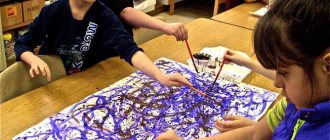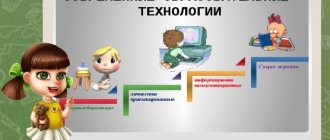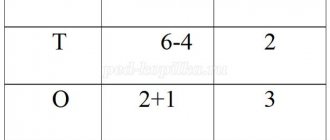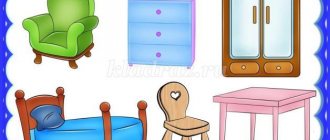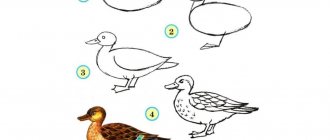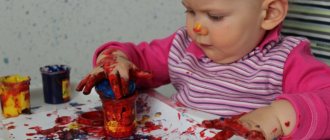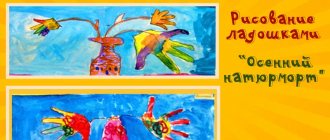On the topic: methodological developments, presentations and notes
Drawing with paints. (fingers).
Summary of an open lesson on drawing in a non-traditional way (poke drawing + emerging drawing) middle group “Animals of our zoo.” compiled by Kuznetsova Svetlana Vladimirovna Put.
The purpose of this lesson is to teach children to reflect the plot of an episode from a fairy tale, conveying its characteristic features: characters, their appearance, emotions, correspondence of the plot to the text of the fairy tale.
This material is aimed at developing fine motor skills of the fingers, creativity, and imagination.
Summary of GCD on modeling according to design in the middle group.
Goal: to study the appearance, character, behavior and habits of the fox. Objectives: to develop the ability to see and name parts of the animal’s body; introduce a new way of depicting the torso and head in f.
Notes for children with disabilities on hearing in the preparatory group.
Source
"Drawing by Design." Summary of GCD in the middle group
Svetlana Panchekhina
"Drawing by Design." Summary of GCD in the middle group
Topic: “By design ”
Program content: Teach children to independently choose the theme of their drawing, bring their plans to the end, hold a pencil correctly, and paint over small parts of the drawing. Develop creativity and imagination. Foster independence.
Materials: colored pencils, album sheets for each child.
Ioo: cognitive development; speech development.
1. Organizational moment. The teacher invites the children to remember what they drew before . (Children's answers.)
Then the teacher explains that today they will
each draw what they want, asking the children what they would like to draw .
2. Drawing technique . The teacher reminds you of the rules of drawing : the ability to hold a pencil correctly, draw large on the entire sheet , paint over the drawing with a pencil, drawing lines and strokes in one direction (from top to bottom or left to right, not to go beyond the contour.
Preview:
Summary of GCD drawing in the middle group
“According to plan” Teacher of the Saransk preschool educational institution “Kindergarten No. 43 of a combined type” Vlasova Alina Evgenievna
Develop creativity and imagination.
Handouts: Colored pencils, album sheet for each child.
Didactic material: Drawings as an example, Masha doll.
Contents of educational activities
1) Educator: Hello Guys, look who came to us today?
-That's right, Masha doll. Let's say hello to her! (Say hello)
-Look how sad the doll Masha is. She told me that she doesn't know how to draw. Guys, can you draw? (Yes)
2) -Let's draw a picture for the doll so that she won't be sad. (Yes)
-What would you like to draw for Masha? (Flower, toy, car)
-What interesting ideas you have, I also drew for the doll: an apple, a tree and a ball. (Hangs out drawings as examples)
-What will we draw today? (Pencils)
-What color are they? (Children begin to list colors)
-But before we draw, let's first stretch our fingers.
Finger gymnastics “Winter fun”
One, two, three, four, five, (bend the fingers on both hands)
It's snowing, let's go for a walk. (wavy movements of hands from top to bottom)
Don’t look for us, mom, (alternately touching identical fingers, starting with the thumbs)
We will build the hill. (connect the ends of your fingers at right angles)
It’s not a simple slide, (put your palms together)
Ice slide (join fingers at an angle)
We will try very hard, (clench your fingers into fists, raise your thumbs up)
So that you can ride it later. (use your right hand to stroke the back of your left hand)
Educator: Before drawing, straighten the backs and legs together. Let's remember how to hold a pencil correctly. (Show)
-The drawing must be drawn on the entire sheet (Follow the instructions)
-We paint completely (The teacher observes while working, helps if necessary)
3) Educator: What did we do today? (Drew drawings for Masha)
-What did you draw with? (Pencils)
(The teacher calls several children in turn to describe their work)
-Well done guys, Masha is glad that you drew so many drawings for her. Let's hang them on a board to admire. Masha will pick them up a little later.
-And now let's say goodbye to the doll Masha (Goodbye Masha!)
Source
Tasks. Learn to draw a human figure in motion, showing changes in appearance (shape and proportions) in connection with the transfer of simple movements. To arouse interest in searching and conveying, using accessible graphic means, characteristic details that make the image expressive and imaginative. Select a contrasting color combination in accordance with the content and character of the image.Preliminary work. Conversation about the circus, circus performances. Consideration of schematic
drawings that convey different movements. Studying facial expressions using a mirror. Drawing and sculpting a “smile”.
Conversation about different emotions.
Materials, tools, equipment. Gouache paints, brushes of 2-3 sizes, sheets of white and tinted paper (of different sizes), jars of water, palettes.
Color models “Rainbow” and “Color Wheel” to demonstrate to children the patterns of color combinations and familiarize them with the phenomenon of color contrast.
Recommended aids, clarity.
Posters “Circus”, “Zoo”, “Multiple”, “Composition of the number 5”, “Composition of the number 10”.
A set of technological maps for sculpting “Circus”.
Contents of the lesson.
The teacher shows the children a clown (toy, illustration, poster) and has a short conversation about who clowns are, what they do, and how clown performances differ from other circus acts.
Then the teacher invites the children to draw funny clowns performing in the circus. It invites you to think about what a clown can do: juggle, walk on his hands, play with a dog, somersault or joke with the audience. He asks the children to smile at each other and asks how to show in the drawing that the clown is cheerful? Shows options for depicting a smile (quick sketches with chalk on a blackboard or charcoal pencil on a sheet of paper).
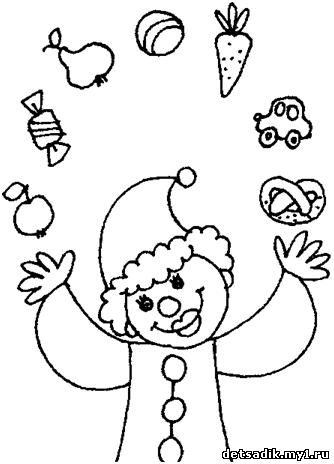
The teacher clarifies the children’s idea of a circus costume: the clown’s outfit is very bright, usually divided by color into two parts (right and left), for example, one half of the costume is green and the other half is red. Shows children the “Rainbow” and “Color Wheel” color models and offers to choose different options for contrasting color combinations (in color pairs - dyads placed opposite each other on the color wheel): blue and red, blue and yellow, blue and orange, etc. If there is an opportunity, the teacher shows the children an illustration or photograph of a clown in a suit or explains the principle of contrast by selecting pairs of colored pieces of paper.
The teacher asks how the children will draw a clown costume so that it turns out to be two-color. Specifies the sequence of work (with chalk on a blackboard or with a charcoal pencil on a sheet of paper placed on an easel).
Reminds children how to get pink or flesh color to paint the face and hands of a clown (mix paints on a palette or board, adding a few drops of red brown to white.
Children choose the color and format of the background, create a complex color (pink, flesh) on the palette and begin to draw a cheerful clown in motion. At the end of the lesson there is an express exhibition of portraits.
After class. In their free time, the teacher invites children (optional) to compose descriptive or
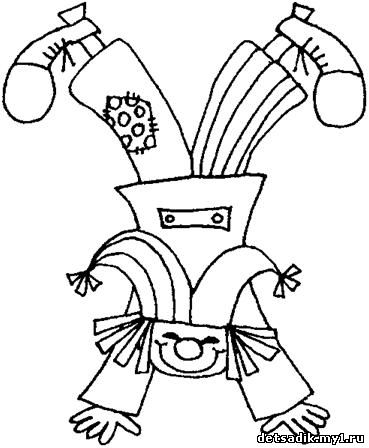
plot stories about their clowns.
Reading the story by G.R. Lagzdyn "Clown":
There is a clown living in our garden.
Only he is without a head.
The dogs dragged the clown in its teeth.
We took it away and washed it.
Now the clown is ours.
Deniska says that the clown probably worked in the circus, then fell and lost his head. Deniska also says that lizards’ tails come off. Once a lizard loses its tail, it will grow back. And the clown, says Deniska, can grow a head.
But we didn’t believe Denis. The lizard's tail may grow, it's alive. What about the clown? He's not alive, is he? Rag?!
“Let’s,” the teacher suggested, “let’s sew a new head for the clown.”
- Let's! — we agreed and got to work. Now our clown has a head. He smiles and winks with one eye, and has a cap with a tassel on his red hair.
Problems solved using free drawing
Description of the technique
Classes are held in a group and, less frequently, individually. Each listener receives a sheet of paper, paint (non-toxic gouache or watercolor), brushes and a jar of water. The first instruction is given: “You see paints in front of you. Take the ones you like and draw." Only those who find themselves in difficulty are given the following clarification: “If you don’t know what to draw, draw stripes.” This is why colored stripes are a component of many designs, but no one is limited to them. Authors who have completed the drawing receive the next sheet, and so on, as long as the desire to draw remains. Discussion follows. Everyone talks about their feelings during the drawing process. The remaining participants express their impressions (feelings, associations) in connection with the drawing. On the back, the author signs the drawing and indicates with arrows the sequence of development of the image on paper.
Problems solved using free drawing
Current. Expression in the drawing and awareness when discussing one’s own psychological motives, attitudes, feelings, relationships. Change of feelings under the influence of free drawing. Achieving better mutual understanding and self-understanding. Accepting each person's individuality (as expressed in their drawing). Awareness of the need to introduce a child to spontaneous visual activities from an early age.
Changes in feelings under the influence of free drawing (how feelings change is described in the example below)
. Free drawing helps to discover, express experiences and, as a result, change them. The dynamics of feelings can be traced in a number of sequential drawings.
(An example for course leaders to understand) This happened with Katya L’s drawings. She made the first drawing under the impression of the explosion of a neighboring house that occurred the following night: a sheet of paper was covered with stripes from top to bottom: first blue, then yellow, green, again yellow and light -blue. Thus, as the paper was filled, the colors became lighter. She made the second drawing from the bottom up and completed it with an image of a house. According to subjective sensations, during the process of drawing, the feeling of anxiety that oppressed the woman (she came to class with tears in her eyes) weakened and ceased to burden her.
Thus, the free drawing technique is a necessary component of psychological work with the family during the period of expecting a child, performing a number of tasks, both relevant during pregnancy and long-term, aimed at the development of the child in the future.
2. What follows is the pregnant woman’s story about what she drew for her experiences.
3. Next, I propose to ask the question, What do you need so that fear ceases to be fear? To neutralize him? Or reduce it.
Sometimes pregnant women (and all of us) are simply afraid and give in to fear. Our task is to acknowledge fear and look at it from the outside. And maybe you can see how to reduce it.
For example:
A pregnant woman is afraid that she will not be able to cope with the child after birth. And he draws his fear and names it. And we ask her a question: What do you need so that fear ceases to be fear? To neutralize him? Or reduce it. And she suddenly realizes that fear is not abstract, but that there is a real opportunity to reduce it. She answers: ask your sister for help, invite a breastfeeding consultant, study the necessary information on the course, etc....
4. Of course, there are fears that cannot be completely removed; they are not subject to anyone except God. Then our task is to reduce the power and impact of this fear. We ourselves do not mention such horrors out loud to pregnant women, so that their imagination does not run wild, and so as not to give them new fears. They talk about them themselves.
!!!!!For fear of pain
(which is to some extent inevitable, of course) I propose the following.
Why does a woman need childbirth? -ask pregnant women. What will they answer?
During childbirth, not only a new life is born, but also a “mother”. Childbirth is about patience, which will now be vital. The value of a child increases during childbirth, because It would be strange to give birth without pain and sensations, to awaken some emotions in a woman. Childbirth is the beginning of new challenges and childbirth is the first stage.
Why is pain needed? What did the pregnant women say? - childbirth begins at night, pain is needed so that the female does not sleep and is alert, otherwise she will oversleep and trouble may happen. Pain is adrenaline, which means the meeting with the child will be as emotional as possible in order to awaken the maternal instinct and in order to lock the child in with the mother, and not with those who are still present at the birth (then it would not matter who the newborn is given to)
NATURE HAS PROVIDED EVERYTHING, EVERYTHING THAT HAPPENS IS ALL NECESSARY.
Out of 10 hours of labor, 2 hours of contractions and only the last 2 hours are as intense as possible
(according to the calculations of the candidate of biological sciences Lansburg, I did not recalculate). Can I be patient??????
!!!!!I also suggest meditation for all fears beyond our control,
in which we agree, YES, there is fear, I am familiar with it, but I can live with it and use it to my advantage.
Fear is my assistant, it is a hint indicating what needs to be paid special attention to, it is an ally. Thanks to our fears, we came to the courses! Fine? Certainly! We are looking for a good obstetrician, maternity hospital, pediatrician, consultant. Fine? Great! We are looking for information to be fully armed, we are preparing for a new rhythm of life. And all this development is thanks to our fears! After all, in the end, fear will remain an imaginary, imaginary event, and how many positive results and achievements are thanks to our fears!!!
Thanks to our fears!
So, auto-training or meditation.
I close my eyes and take a deep breath and exhale smoothly.
I see my fear, it can be big or small, round or square, gray, black or another dark color. I look at him, I look at him.
I see it and concentrate on it, I see nothing but my fear, I have it. Name your fear. What is this fear? What are you afraid of?
I start cleaning my fear, maybe vacuuming, maybe washing, maybe sweeping or laundering, as you like. It begins to brighten. I clean it until it becomes light, clean, possibly transparent.
Give your fear a name, a nickname, or just a name. How can you call him affectionately, perhaps with humor?
Hello my fear (call it by name). Now I will call you that, only by name. Thank you for having me. I thank you for your help. I know you.
I promise you that I will always remember you and will never forget about you. I will wish you good morning and good night. I will greet you every time I think of you.
Therefore, you can be calm and not remind yourself. There is no need to come to me, I will call you when I need you.
I take a deep breath and exhale smoothly and open my eyes.
After the meditation, homework assignments until the birth. Find or buy some item at home (for example, an unnecessary soft toy) and assign it that same fear. Place her in a prominent place and call her by the same name that she was given during meditation. And greet him when passing by (Oh, hello, cousin!) Do not forget to greet him and wish him good night)))
The goal is to recognize it, be able to live with it, make it common in your life. As a result, it will become familiar and you will stop noticing it. You will stop noticing your fear!!!!!!
5. One more point in working with fears.
You ask pregnant women what your mother told you about her birth.
.
3 minutes and they write about it. Let's discuss further.
Often we don’t even realize how deeply our mothers’ birth experience has ingrained itself in us.
! Very rarely was it positive.
They remember that mom couldn’t, it was embarrassing, it wasn’t nice, phrases like “yes, you’ll never be able to feed, because... you have the same breasts as me, and I had little milk, etc….” And we talk.
In this task, it is important to talk about this experience so that it comes to the surface from the subconscious. When a pregnant woman confronts this experience, she realizes that it can interfere with her labor. And now she can sort it out for herself, because now she knows everything about childbirth!
Information for pregnant women!
- Your birth, breastfeeding, etc. are individual, exact repetition is not possible!!! This has been confirmed by thousands and millions of births!
- We don’t even know what kind of woman in the family is pregnant genetically. looks like repeating someone's birth scenario. No program!
“Our mothers did not have the knowledge, they were trained to give birth on the run, throw the child in the nursery, not feed, not pick up the child and run to build a bright future! Can they have other experiences other than negative ones?
- You will not be like your mother, you are not a mother, besides, you also have your dad.
If the pregnant woman wishes, she can correct her drawing at the end of the lesson and show that she is the mistress herself and decides for herself whether to be afraid or not. Everything is in her hands
| To ruin the birth, you need to come to the birth in fear, squeeze and be afraid. Hormones of fear block the hormone of childbirth - oxytacin and natural pain relief - endorphin. |
Recommended pages:
Use the site search:
